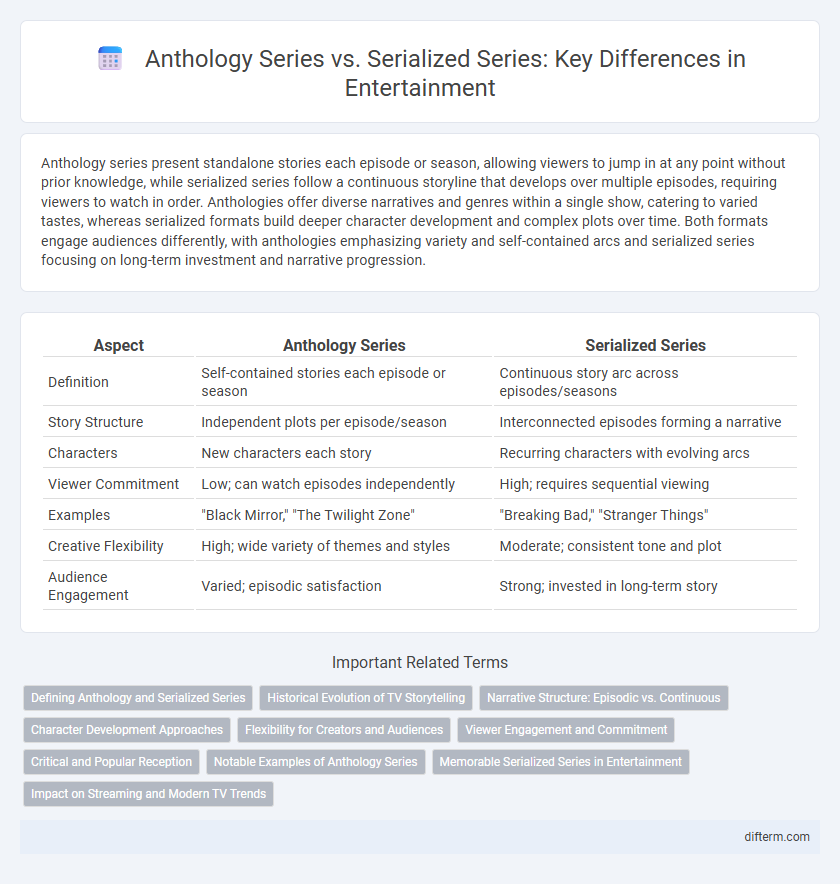Anthology series present standalone stories each episode or season, allowing viewers to jump in at any point without prior knowledge, while serialized series follow a continuous storyline that develops over multiple episodes, requiring viewers to watch in order. Anthologies offer diverse narratives and genres within a single show, catering to varied tastes, whereas serialized formats build deeper character development and complex plots over time. Both formats engage audiences differently, with anthologies emphasizing variety and self-contained arcs and serialized series focusing on long-term investment and narrative progression.
Table of Comparison
| Aspect | Anthology Series | Serialized Series |
|---|---|---|
| Definition | Self-contained stories each episode or season | Continuous story arc across episodes/seasons |
| Story Structure | Independent plots per episode/season | Interconnected episodes forming a narrative |
| Characters | New characters each story | Recurring characters with evolving arcs |
| Viewer Commitment | Low; can watch episodes independently | High; requires sequential viewing |
| Examples | "Black Mirror," "The Twilight Zone" | "Breaking Bad," "Stranger Things" |
| Creative Flexibility | High; wide variety of themes and styles | Moderate; consistent tone and plot |
| Audience Engagement | Varied; episodic satisfaction | Strong; invested in long-term story |
Defining Anthology and Serialized Series
Anthology series feature self-contained episodes or seasons with distinct stories, characters, and settings, offering viewers varied narratives without the need for prior viewing. Serialized series present continuous storylines across episodes or seasons, emphasizing character development and plot progression that require sequential watching. Understanding these formats helps audiences choose content based on their preference for standalone tales or evolving narratives.
Historical Evolution of TV Storytelling
Anthology series, popularized in the early days of television such as with "The Twilight Zone" (1959), revolutionized TV storytelling by presenting standalone episodes with unique plots and characters, allowing for diverse narratives and themes. Serialized series, exemplified by shows like "Dallas" (1978), emerged later to create continuous, interconnected story arcs that build character development over multiple episodes and seasons, driving deeper audience engagement. The historical evolution from anthology to serialized formats reflects changing viewer preferences and technological advances, shaping how complex stories are delivered on television today.
Narrative Structure: Episodic vs. Continuous
Anthology series deliver self-contained episodes with distinct plots and characters, allowing viewers to jump in at any point without prior knowledge. Serialized series feature continuous story arcs that develop over multiple episodes, requiring sequential viewing for full narrative comprehension. This narrative structure difference impacts audience engagement, with anthology formats favoring episodic closure and serialized formats promoting long-term investment.
Character Development Approaches
Anthology series present self-contained stories each season or episode, allowing characters to undergo distinct arcs without long-term continuity constraints, fostering intense but brief development. Serialized series build character evolution gradually over multiple episodes or seasons, deepening emotional investment and complex growth through ongoing plotlines. The narrative structure of serialized series facilitates multifaceted character journeys, while anthology formats emphasize thematic variety with concentrated character exploration.
Flexibility for Creators and Audiences
Anthology series offer unparalleled flexibility for creators by allowing them to explore diverse narratives, genres, and characters within each episode or season, catering to varied audience preferences without the constraints of a continuous storyline. Serialized series demand consistent character development and plot progression, which can limit creative experimentation but foster deep engagement through ongoing arcs. Audiences benefit from the choice between the episodic closure found in anthologies and the immersive, layered storytelling characteristic of serialized formats.
Viewer Engagement and Commitment
Anthology series offer viewers self-contained stories each episode or season, appealing to audiences who prefer diverse narratives without long-term commitment. Serialized series require sustained viewer engagement through ongoing plotlines, fostering deeper emotional investment and character development over time. This continuous storyline often results in higher audience retention and loyalty compared to episodic anthologies.
Critical and Popular Reception
Anthology series often receive critical acclaim for their unique storytelling approach and ability to explore diverse themes in a single season, attracting viewers seeking fresh narratives. Serialized series tend to build loyal fan bases through deep character development and ongoing plotlines, resulting in high viewer engagement and social media buzz. Popular reception frequently favors serialized narratives for their binge-watching appeal, while critics highlight anthologies for their artistic innovation and thematic variety.
Notable Examples of Anthology Series
Notable examples of anthology series include "The Twilight Zone," which revolutionized speculative fiction with standalone episodes exploring social issues, and "Black Mirror," known for its dystopian view of technology and society. "American Horror Story" redefined the genre by blending horror themes with recurring actors while offering new plots each season. These series showcase diverse storytelling, allowing creators to experiment with different characters and settings without the constraints of a continuous narrative.
Memorable Serialized Series in Entertainment
Memorable serialized series such as "Breaking Bad," "Game of Thrones," and "Stranger Things" captivate audiences with continuous story arcs that develop complex characters and intricate plots over multiple episodes. These shows leverage long-form storytelling to build emotional investment and sustained suspense, often resulting in higher viewer engagement and critical acclaim. Unlike anthology series, serialized dramas create a cohesive narrative experience that encourages binge-watching and deep fan communities.
Impact on Streaming and Modern TV Trends
Anthology series offer unique, self-contained stories each episode or season, attracting viewers seeking variety on streaming platforms like Netflix and Hulu. Serialized series create long-form narratives that drive binge-watching behavior and subscription retention, aligning with modern TV trends favoring deep character development and ongoing plotlines. Streaming services increasingly balance both formats to maximize audience engagement and cater to diverse viewer preferences.
anthology series vs serialized series Infographic

 difterm.com
difterm.com